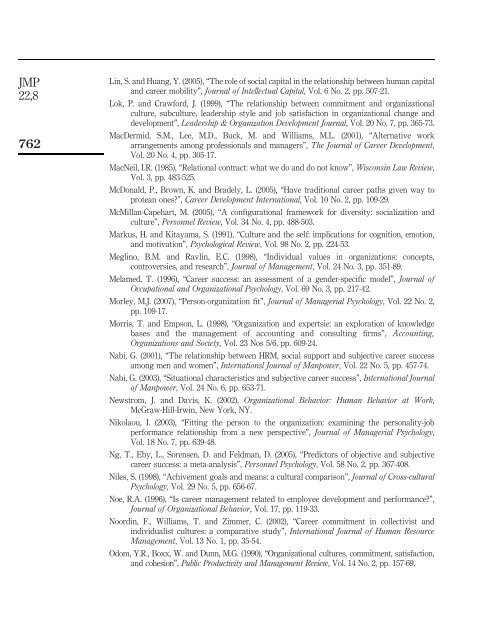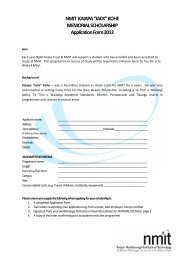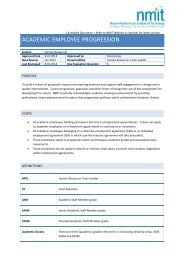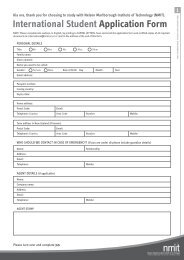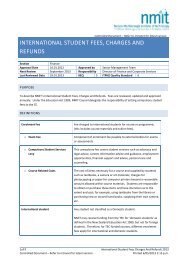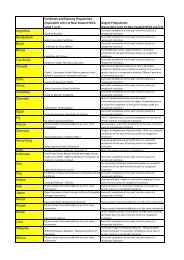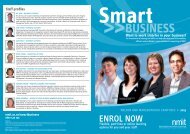JMP22,8762Lin, S. and Huang, Y. (2005), “The role of social capital in the relationship between human capitaland career mobility”, Journal of Intellectual Capital, Vol. 6 No. 2, pp. 507-21.Lok, P. and Crawford, J. (1999), “The relationship between commitment and organizationalculture, subculture, leadership style and job satisfaction in organizational change anddevelopment”, Leadership & Organization Development Journal, Vol. 20 No. 7, pp. 365-73.MacDermid, S.M., Lee, M.D., Buck, M. and Williams, M.L. (2001), “Alternative workarrangements among professionals and managers”, The Journal of <strong>Career</strong> Development,Vol. 20 No. 4, pp. 305-17.MacNeil, I.R. (1985), “Relational contract: what we do and do not know”, Wisconsin Law Review,Vol. 3, pp. 483-525.McDonald, P., Brown, K. and Bradely, L. (2005), “Have traditional career paths given way toprotean ones?”, <strong>Career</strong> Development International, Vol. 10 No. 2, pp. 109-29.McMillan-Capehart, M. (2005), “A configurational framework for diversity: socialization andculture”, Personnel Review, Vol. 34 No. 4, pp. 488-503.Markus, H. and Kitayama, S. (1991), “Culture and the self: implications for cognition, emotion,and motivation”, Psychological Review, Vol. 98 No. 2, pp. 224-53.Meglino, B.M. and Ravlin, E.C. (1998), “Individual values in organizations: concepts,controversies, and research”, Journal of Management, Vol. 24 No. 3, pp. 351-89.Melamed, T. (1996), “<strong>Career</strong> <strong>success</strong>: an assessment of a gender-specific model”, Journal ofOccupational and Organizational Psychology, Vol. 69 No. 3, pp. 217-42.Morley, M.J. (2007), “Person-organization fit”, Journal of Managerial Psychology, Vol. 22 No. 2,pp. 109-17.Morris, T. and Empson, L. (1998), “Organization and expertsie: an exploration of knowledgebases and the management of accounting and consulting firms”, Accounting,Organizations and Society, Vol. 23 Nos 5/6, pp. 609-24.Nabi, G. (2001), “The relationship between HRM, social support and subjective career <strong>success</strong>among men and women”, Internationsl Journal of Manpower, Vol. 22 No. 5, pp. 457-74.Nabi, G. (2003), “Situational characteristics and subjective career <strong>success</strong>”, International Journalof Manpower, Vol. 24 No. 6, pp. 653-71.Newstrom, J. and Davis, K. (2002), Organizational Behavior: Human Behavior at Work,McGraw-Hill-Irwin, New York, NY.Nikolaou, I. (2003), “Fitting the person to the organization: examining the personality-jobperformance relationship from a new perspective”, Journal of Managerial Psychology,Vol. 18 No. 7, pp. 639-48.Ng, T., Eby, L., Sorensen, D. and Feldman, D. (2005), “Predictors of objective and subjectivecareer <strong>success</strong>: a meta-analysis”, Personnel Psychology, Vol. 58 No. 2, pp. 367-408.Niles, S. (1998), “Achivement goals and means: a cultural comparison”, Journal of Cross-culturalPsychology, Vol. 29 No. 5, pp. 656-67.Noe, R.A. (1996), “Is career management related to employee development and performance?”,Journal of Organizational Behavior, Vol. 17, pp. 119-33.Noordin, F., Williams, T. and Zimmer, C. (2002), “<strong>Career</strong> commitment in collectivist andindividualist cultures: a comparative study”, International Journal of Human ResourceManagement, Vol. 13 No. 1, pp. 35-54.Odom, Y.R., Boxx, W. and Dunn, M.G. (1990), “Organizational cultures, commitment, satisfaction,and cohesion”, Public Productivity and Management Review, Vol. 14 No. 2, pp. 157-69.
Okabe, Y. (2002), “Culture or employment systems? Accounting for the attitudinal differencesbetween British and Japanese managers”, The International Journal of Human ResourceManagement, Vol. 13 No. 2, pp. 285-301.Oliver, J. (1997), “The new-look fast track”, Management Today, March, pp. 86-9.O’Neil, B.S. and Adya, M. (2007), “Knowledge sharing and the psychological contract”, Journal ofManagerial Psychology, Vol. 22 No. 4, pp. 411-36.O’Reilly, C.A. (1989), “Corporations, culture, and commitment: motivation and social control inorganizations”, California Management Review, Vol. 31 No. 4, pp. 9-25.O’Reilly, C.A., Chatman, J. and Caldwell, D.F. (1991), “People and organizational culture: a profilecomparison approach to assessing person-organization fit”, Academy of ManagementJournal, Vol. 34 No. 3, pp. 487-516.Ostroff, C., Shin, Y. and Kinicki, A.J. (2005), “Multiple perspectives of congruence: relationshipsbetween value congruence and employee attidudes”, Journal of Organizational Behavior,Vol. 26, pp. 591-623.Pappas, J. and Flaherty, K.E. (2006), “The moderating role of individual-difference variables incompensation research”, Journal of Managerial Psychology, Vol. 21 No. 1, pp. 19-35.Parker, P. (2002), “Working with the intelligent career model”, Journal of EmploymentCounseling, Vol. 39 No. 2, pp. 83-94.Parkes, L., Bochner, S. and Schneider, S. (2001), “Person-organization fit across cultures:an empirical investigation of individualism and collectivism”, Applied Psychology:An International Review, Vol. 50 No. 1, pp. 81-108.Peiperl, M. and Baruch, Y. (1997), “Back to square zero: the post-corporate career”,Organizational Dynamics, Vol. 25 No. 4, pp. 7-22.Pfeffer, J. (1977), “Effects of an MBA degree and socioeconomic origins on business schoolgraduates’ salaries”, Journal of Applied Psychology, Vol. 6, pp. 698-705.Peters, T. and Waterman, R. (1982), In Search of Excellence, Harper & Row, London.Piasentin, K. and Chapman, D. (2006), “Subjective person-organization fit: bridging the gap betweenconceptualization and measurement”, Journal of Vocational Behavior, Vol. 69 No. 2, pp. 202-21.Rhoades, L. and Eisenberger, R. (2002), “Perceived organizational support: a review of theliterature”, Journal of Applied Psychology, Vol. 87 No. 4, pp. 698-714.Robinson, S.L., Kraatz, M.S. and Rousseau, D.M. (1994), “Changing obligations and the psychologicalcontract: a longitudinal study”, Academy of Management Journal, Vol. 19 No. 4, pp. 137-52.Rosenbaum, J.E. (1989), “Organizational career systems and employee misperceptions”, inArthur, M.B., Hall, D.T. and Lawrence, B.S. (Eds), Handbook of <strong>Career</strong> Theory, CambridgeUniversity Press, New York, NY, pp. 329-53.Rousseau, D.M. (1995), Pschological Contracts in Organizations: Understanding Written andUnwritten Agreements, Sage, Thousand Oaks, CA.Rousseau, D.M. (2004), “Psychological contracts in the workplace: understanding the ties thatmotivate”, Academy of Management Executive, Vol. 18 No. 1, pp. 120-7.Rousseau, D. and Parks, J. (1992), “The contracts of individuals and organizations”, inCummings, L.L. and Staw, B.M. (Eds), Research in Organizational Behavior, Vol. 15,JAI Press, Greenwich, CT, pp. 1-47.Schneider, B. (1987), “The people make the place”, Personnel Psychology, Vol. 40 No. 3, pp. 437-53.Schneider, B. (2001), “Fits about fit”, Applied Psychology: An International Review, Vol. 50 No. 1,pp. 141-52.Schneider, B., Goldtein, H.W. and Smith, D.B. (1995), “The ASA framework: an update”,Personnel Psychology, Vol. 48 No. 4, pp. 747-73.<strong>Career</strong> <strong>success</strong>763
- Page 5: the contract is a contract with one
- Page 8: JMP22,8748Bauer, 2005). Werbel and
- Page 12 and 13: JMP22,8752supervisors) in their wor
- Page 14 and 15: JMP22,8754P4. PC fit is likely to b
- Page 16 and 17: JMP22,8756to investigate the effect
- Page 18 and 19: JMP22,8758To conclude, career succe
- Page 20 and 21: JMP22,8760Crant, J.M. (1995), “Th
- Page 24: JMP22,8764Seibert, S.E., Crant, J.M


